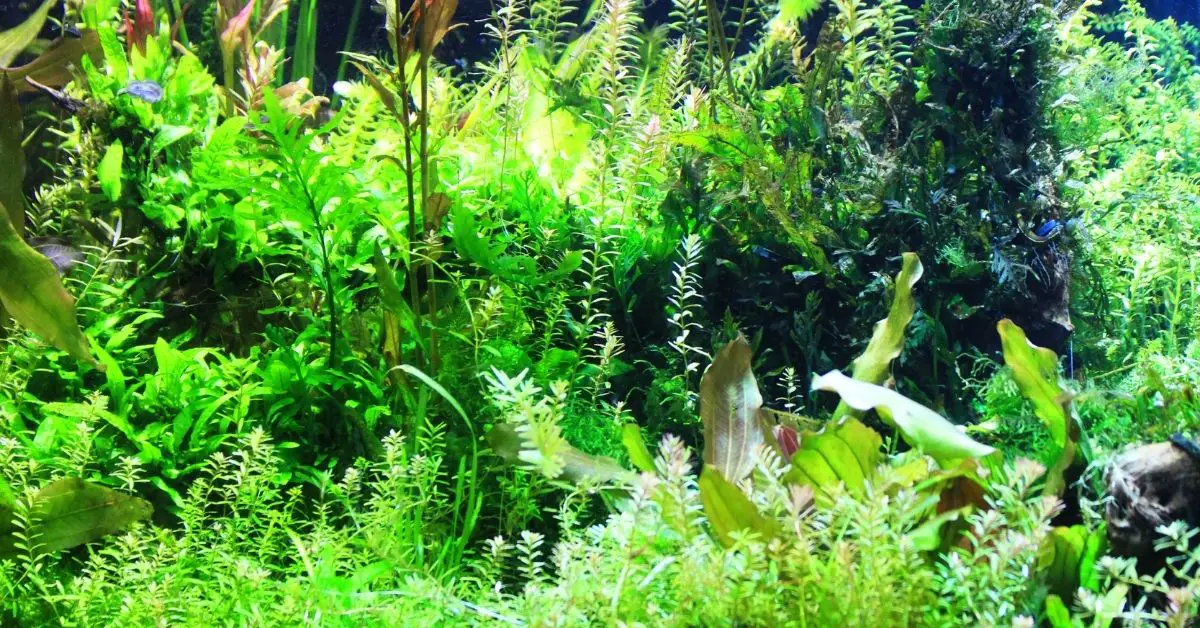Hundreds of plants are available to the freshwater aquarist, and selecting the right species means matching the optimum conditions for the plants to the needs of your fish and shrimp. Plants and fish should share water chemistry needs and thrive under the same lighting conditions. Themed tanks, in which the geographical origins of fish and plants are matched, can work well. If your tank fish browse on vegetation, avoid slow-growing plants, which will not recover quickly enough; similarly, avoid prolific species that will soon outgrow a small tank.
How to keep freshwater plants healthy?
Lighting
the first thing is your lighting. You have to have good lighting in your tank, it’s the number one thing that drives your plants to grow. If you have poor lighting – you’re gonna have poor plant growth it’s as simple as that.
Nutrients and substrate
Number two is always gonna be nutrients and good substrate. The high fish load in your tank, bacteria and the substrate can break it down and turn it into nutrients for your plants.
Fertilizers
I do recommend you dose at least once a day if you have a high Plants load, and at least once a week if you don’t have high plants load. Dosing the water column with fertilizer actually makes your substrate last longer. Some people say it lasts two to three years, personally, I haven’t made it that far yet.
That’s the the shortest way I can put it on how to keep your plants healthy.
Fluval Bug Bites Bottom Feeder Fish Food, Granules for Small to Medium Sized Fish, 1.60 Oz., A6586
$3.81 (as of June 16, 2025 18:57 GMT +03:00 - More infoProduct prices and availability are accurate as of the date/time indicated and are subject to change. Any price and availability information displayed on [relevant Amazon Site(s), as applicable] at the time of purchase will apply to the purchase of this product.)Boyd Enterprises Chemi-Pure Filtration Media for Aquarium, 11-Ounce, Blue
10% OffUltum Nature Systems Ultra Clear Rimless Aquarium - Low Iron Glass Fish Tank with 45° Mitered Edges, 5mm-12mm Thick, Leveling Mat Included (16C, Cube, 1 Gallon)
$38.49 (as of June 16, 2025 18:57 GMT +03:00 - More infoProduct prices and availability are accurate as of the date/time indicated and are subject to change. Any price and availability information displayed on [relevant Amazon Site(s), as applicable] at the time of purchase will apply to the purchase of this product.)Why do you sterilize freshwater plants?
It’s a really good idea to sterilize any plants that you get before you put them in your aquarium, and this is just because a lot of the plants we get, come from tanks in our local pet stores, and these tanks usually have fish in them, and the fish may be carrying some sort of parasite, bacteria or something and the plants can actually bring those into your aquarium with them, if you just put them right from the store into your tank. So it’s just a good thing to do, to sterilize them before you put them into your tank just to make sure that you get rid of any potentially harmful pathogens that those plants might be carrying.
Here Are Some Of The Best Freshwater Plants:
Java Moss
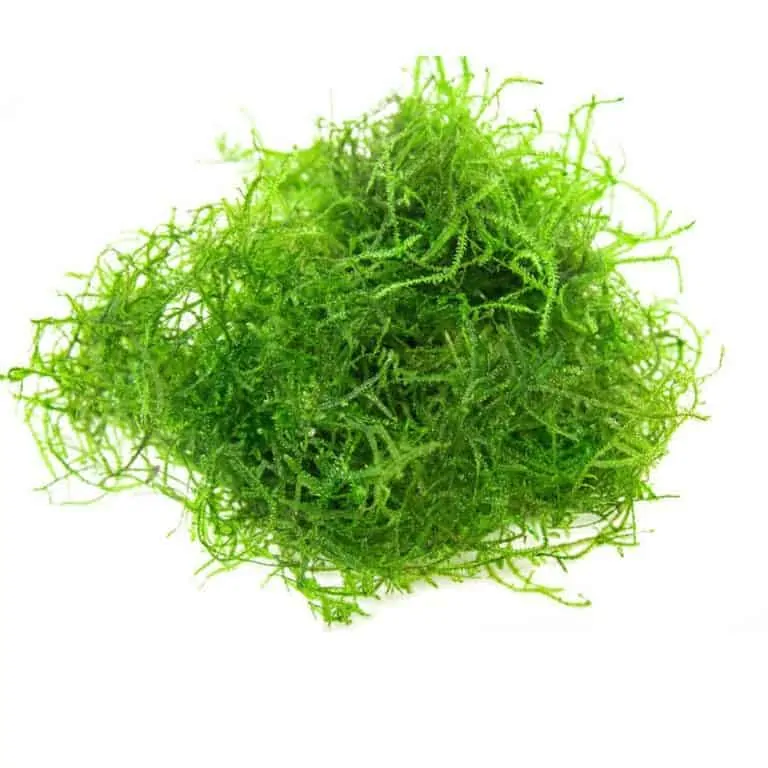
This moss will help to create a natural aquascape, growing readily over rockwork and on bogwood. In the first instance, attach it with an elastic band and allow it to put down its rootlike hapterons, which will bind it in place. Take care to ensure that the lighting is not too bright, otherwise, the Java moss will be overgrown by algae in the water.
Madagascar Lace plant
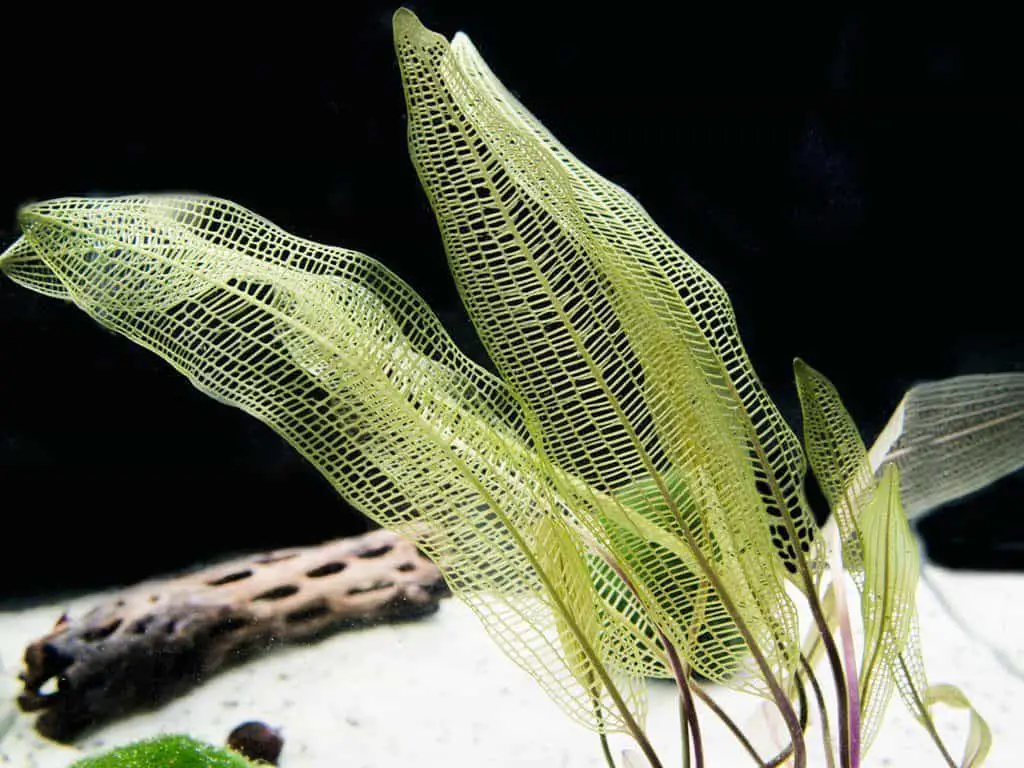
Madagascar Lace plants will grow readily from rhizomes, but they can be tricky to maintain. Shade them from bright light and keep them cool. Well-filtered water will stop debris from clogging their open leaf structure and prevent contamination by algae.
Java Fern
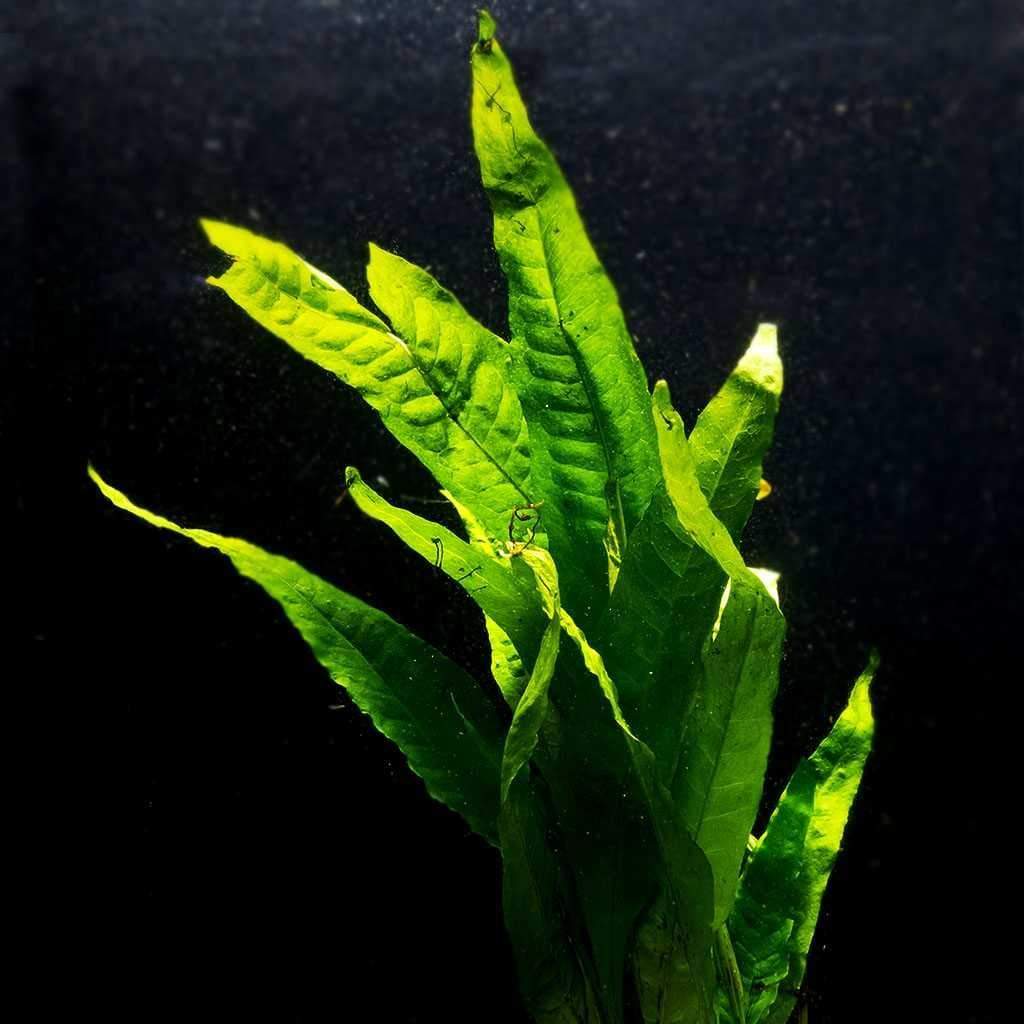
The tough nature of Java Fern enables it to survive in tanks where most plants would be destroyed by the fish, although there have been suggestions that it is toxic to a few species. The rhizome should be attached to the decor with an elastic band, rather than set in the substrate. The fronds will develop transparent areas if the lighting is too bright.
Giant Red Rotala
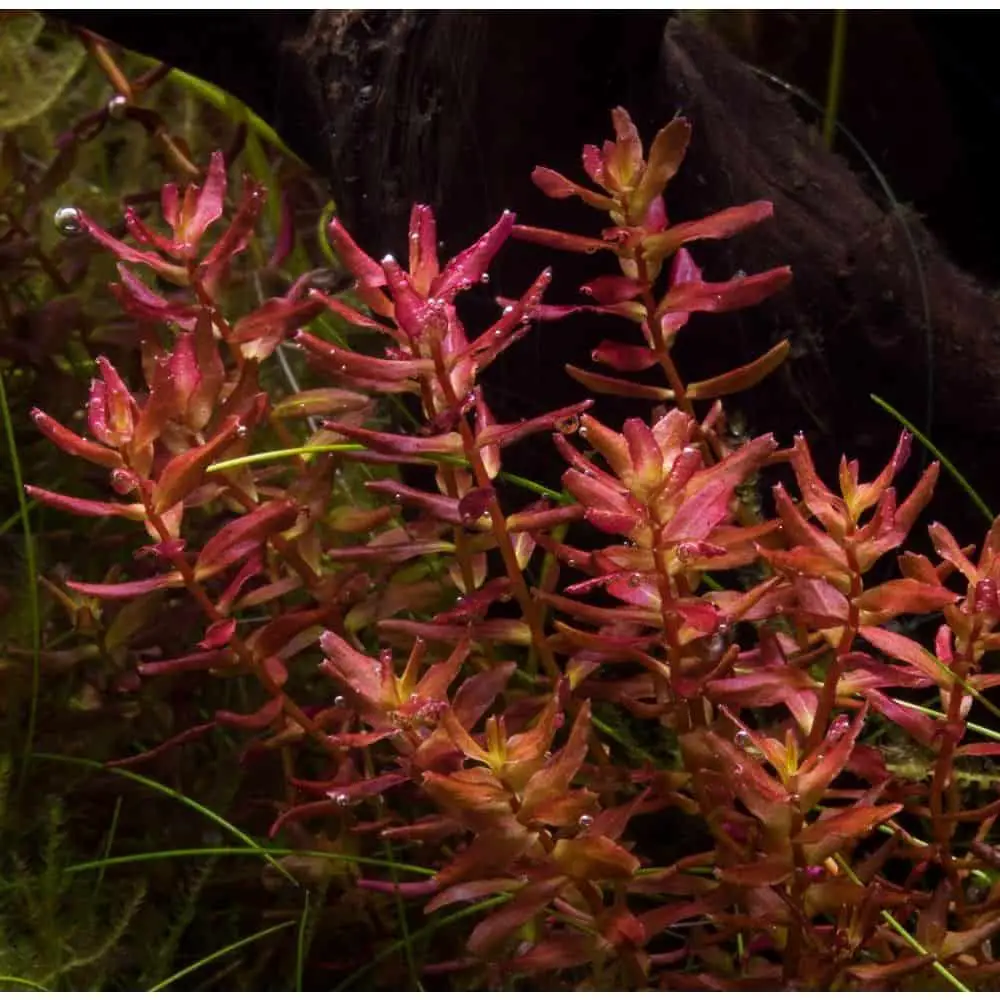
Bright lighting accentuates the red coloration of this attractive species. Unfortunately, Giant Red Rotala is difficult to establish in aquariums, and it can be damaged easily by rough handling. However, it is worth the effort, because it makes a striking contrast with green plants. To create the best effect, plant shoots in groups.
Onion Plant
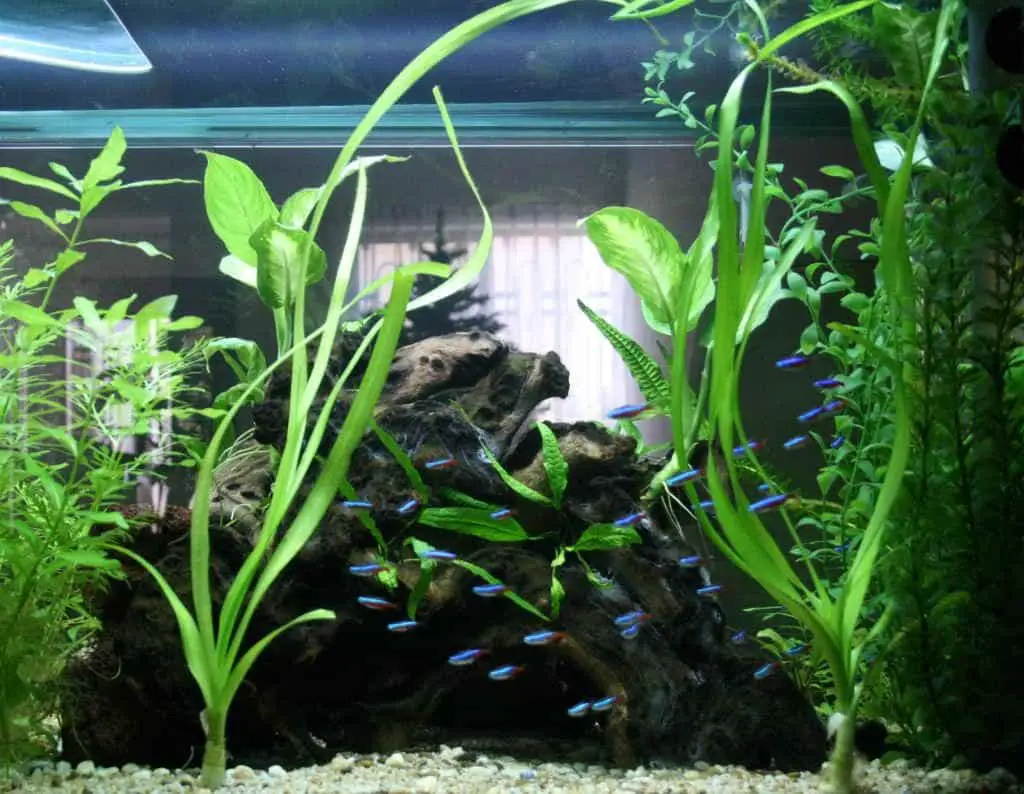
Numerous types of Onion Plant are available, all of which reach a relatively large size. The straplike leaves can be up to 3 in (7.5 cm) wide and are variable shades of green. In the wild, the Onion Plant will often grow above the surface, and it is then that it produces its characteristic white flower. The flower reveals that this is not a member of the onion family, but a relative of the popular Amaryllis houseplant. The Onion Plant looks best in a large, deep aquarium, especially when planted toward the back of the tank. If the bulb is set deep in the substrate, with just its shoulder visible, it should soon establish itself and start sprouting leaves. Onion Plants are quite tough, so they can be incorporated successfully in aquariums housing large vegetarian fish, where more delicate plants would be consumed. They are also unfussy about their water conditions and do not require brightly lit surroundings.
African Tiger Lotus
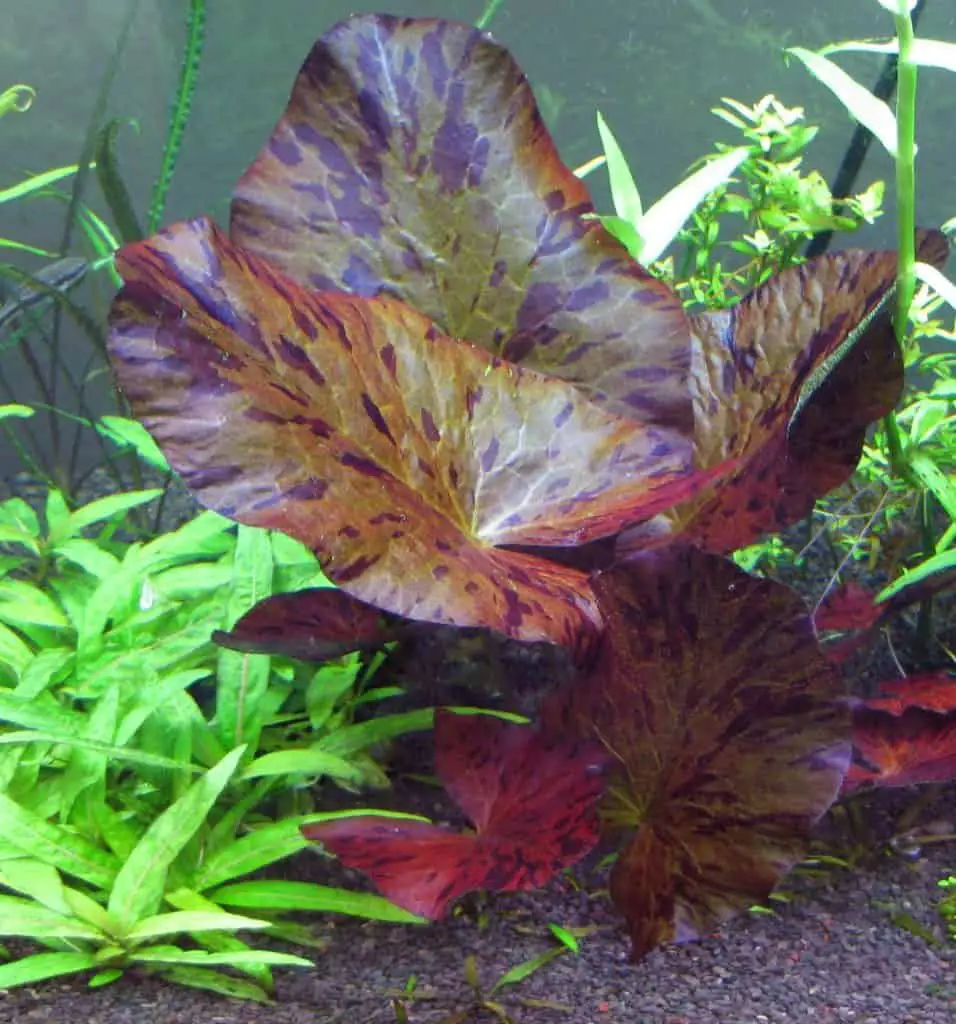
The Tiger Lotus, a broad-leaved relative of the water lily, has two distinct forms. The African Tiger Lotus, shown here, has greenish leaves with purple blotches and pale green undersides. The Red Tiger Lotus has reddish leaves, again marked with purple. Once planted in the substrate, tubers should grow rapidly under bright light. The leaves, up to 6 in (15 cm) in diameter, provide retreats for small fish. Tiger Lotuses may flower in the tank, producing white blooms above the surface that open at night. If the resulting seeds are left to fall into the tank, they may germinate on the substrate.
Orchid Lily
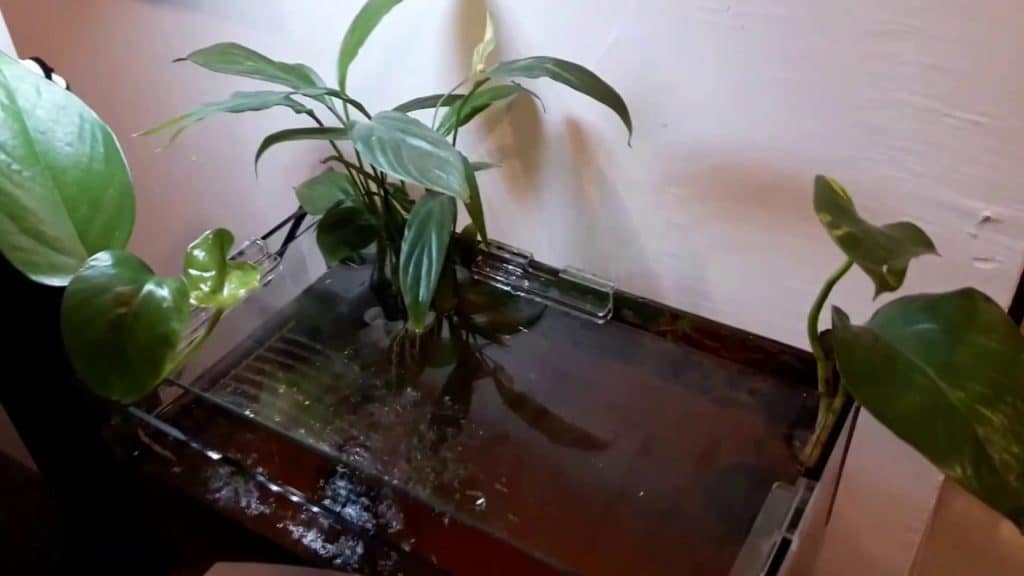
The Orchid Lily produces a series of attractive upright leaves and may even bloom on occasion. The red flower produced is able to self-fertilize. Under brightly lit conditions, the leaves will be green, but relatively subdued lighting will bring out a more brownish tone. The substrate must be non-alkaline for this plant to thrive.
Giant Red Bacopa
The leaves of this plant have no stalk but attach directly to the stems. They display a rich coppery color in bright light but appear more green under subdued illumination. A variegated form is also sometimes available. In the wild, the Giant Red Bacopa often grows as a bog plant above the water, but it thrives equally well submerged in a tank.
Glosso
This small plant is ideal for the foreground of the tank, creating a pleasing carpet of growth that provides a refuge for the fish fry. It spreads through the substrate and benefits from small amounts of aquarium plant fertilizer. If its surroundings are not well lit, Glosso will become taller and rather straggly in appearance.
Red Telanthera
This plant may be found growing above the water’s surface in its native habitat, but it adapts well to cultivation underwater in an aquarium. Red Telanthera will only be seen in its full depth of color if the tank is brightly lit. The upper surface of the leaves tends to be greenish with red hues, while purplish-red coloration is concentrated on the undersides. This plant is a good choice for a themed Amazon tank, although it can also be used in a community aquarium. Red Telanthera is best placed at the sides of the tank, or toward the rear. Set cuttings into the substrate so that they grow to form a dense clump, and place green plants of a similar height nearby in order to emphasize the contrasting leaf colors. Make sure you strip off the lower leaves from Red Telanthera before planting, because they will rot if they are buried. Use small rocks to weigh down the bases of the cuttings until they root and become established.
Red Ludwigia
This vigorously growing plant is probably a natural hybrid between Marsh Ludwigia (L. palustris) and a different Red Ludwigia (L. repens). The key requirement of Red Ludwigia is bright light, which will maintain its distinctive red coloration. Because of its rather elongated shape, Red Ludwigia looks at its best when it is planted in clumps. Regular trimming back of the stems should help to ensure a denser, less straggly appearance, and as a result, provide more cover for the fish in the tank. This hardy plant is especially useful in tanks housing fish that require relatively low water temperatures because it will grow well in such surroundings. If it is included in an uncovered tank, it may grow above the water’s surface and subsequently flower, although the white blooms it produces are tiny and inconspicuous.
Banana Plant
Although this adaptable plant will tolerate being permanently submerged in a tank, it prefers shallower waters similar to those of its natural habitat. The leaves of the Banana Plant spread out over the surface in the aquarium, and it may produce white flowers on stalks above the water level. In the wild, the banana-like roots act as a water reservoir to sustain the plant in times of drought.
Cabomba
There are numerous varieties of Cabomba: some have larger whorls of fine leaves than that pictured, and others have mauve-tipped leaves. Good lighting is important for these plants, which are best planted in groups near the back of the tank, using pieces of slate to weigh them down until they take root. Cut back leggy plants to encourage vigorous and compact new growth.
Hornwort
This attractive plant has fine green foliage. It needs to be held down in the substrate with rocks because it has lost the ability to anchor itself with roots. Hornwort is also fragile, and pieces break off easily, usually from the crown. These may then grow at the water’s surface as floating plants. Hornwort fares well under bright light.
Bitter Cress
This is an ideal choice for tropical aquariums. House it with Paradise Fish and other species that share the same waters in the wild. This plant prefers cool surroundings, and may not thrive at temperatures above 68°F (20°C). The leaf form ranges from circular to kidney-shaped. Above the surface, the leaves are pointed, and small, white flowers are produced.
Dwarf Hygrophila
Dwarf Hygrophilia is one of the most adaptable and easily cultivated of all aquarium plants. The long, green leaves sometimes develop red tips when the plant is kept in brightly lit surroundings. This fast-spreading plant will provide valuable cover in the tank, although its growth may be curbed if snails attack the leaves before it becomes established.
Mexican Oak-Leaf Plant
The stems of this plant, which grows upright when submerged, are thick and robust. The tooth-edged, oak-like leaves vary in color from light to dark green. Groups planted near the back of the tank look very attractive. Easy to establish, the Mexican Oak-Leaf Plant thrives not only in brightly lit conditions but also under more subdued lighting.
Twisted Vallisneria
It is unclear whether this plant is a hybrid or a natural variant of the Straight Vallisneria (V. spiralis). Allow space between the plants so that light can penetrate: this is vital for their growth. A larger form is the Asiatic Vallisneria (V. asiatica), which has serrated leaf edges.
Giant Vallisneria
This large, straight-leaved Vallisneria species makes a striking centerpiece for a large aquarium. Cultivated strains that develop a reddish hue under bright light are particularly attractive. Changes in water quality may cause this sensitive plant to die back.
Pygmy Chain Swordplant
Groups of these small sword plants form attractive foreground cover in the tank. Cultivated strains vary in height, so adjustments may be needed once the plants are established. If allowed to grow above the surface in shallow water, the leaves will be broader, and flowers will be produced and may give rise to fertile seed.
Dwarf Sagittaria
A large expanse of this hardy, adaptable plant resembles a grass lawn and provides a safe retreat for fry. To achieve this effect, place several plants in the mid-ground area, with gaps between them. They will soon spread out and fill in the gaps, especially on a coarse gravel substrate.
False Tenellus
Similar in appearance to the Pygmy Chain Swordplant, False Tenellus is a popular choice for the foreground of the tank, partly because it grows well in a wide range of water temperatures. This plant establishes itself readily, and spreads well, especially when planted in a substrate that contains added nutrients. In fact, False Tenellus can be so prolific that its growth may sometimes need to be curbed to prevent it from dominating the tank since this could impair the efficiency of the undergravel filter and lead to a deterioration in water quality. False Tenellus is often sold in bunches, with each plant consisting of one to three narrow leaves that taper to a point and lack a petiole (the part that usually connects a leaf to the stem). Other Lilaeopsis species may also become available to aquarists from time to time, but they all look very much alike and have similar growth characteristics and requirements
Lizard’s Tail
The name of this swamp-dwelling plant derives from the spiked arrangement of its yellowish-white flowers. The leaves, which are a variable shade of green, appear slightly hairy at first, but they become smoother as they age. Lizard’s Tail grows from a rhizome but thrives only when it can spread both above and below the surface. It is a temperate plant, so must not be kept too warm. In a pond, it should be containerized so that it does not damage the lining.

